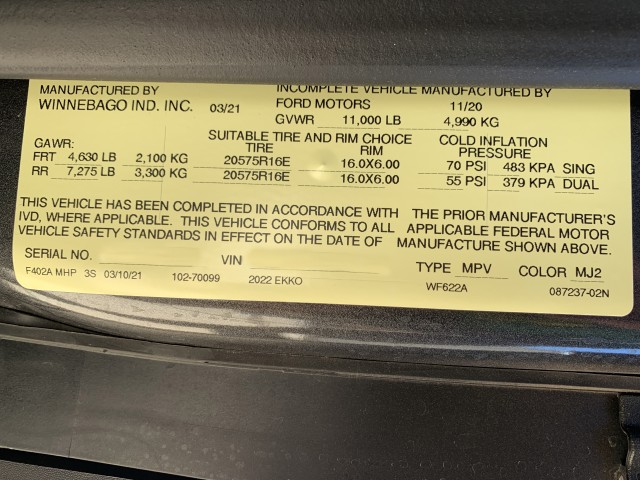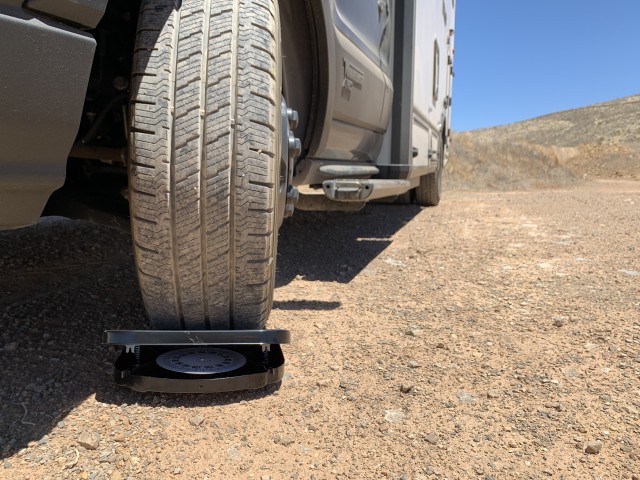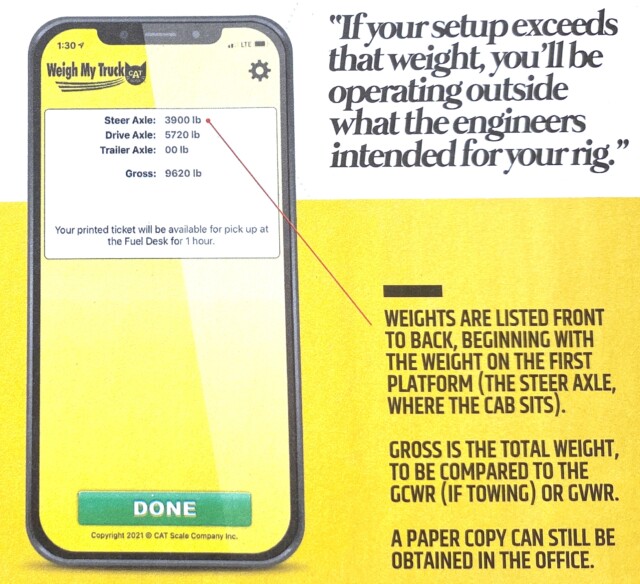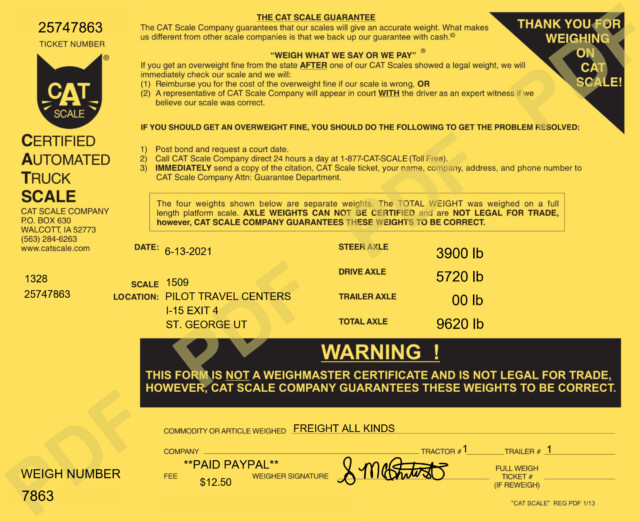This post may contain affiliate links.
If you’ve just purchased an RV, or if you’re in the RV shopping phase, you may have come across the subject of weights. There will be a lot of acronyms tossed about – things like OCCC and GCWR, as well as admonishments about traveling with an “Overweight RV”. I remember being concerned about these things as a new RVer, because nobody had explained it to me, and I had no idea exactly how to determine if my RV was indeed “overweight”.
But just because nobody explained it to me doesn’t mean these aren’t important concepts. They are. And the first thing I want to explain is why you should care. Basically, it all comes down to safety.
Let’s talk about your weight.
Whether it’s a motorhome or a towable, your RV is designed to handle a certain weight. If you go over that weight, you’ll be operating outside what the engineers intended for your rig. Will the suspension be able to handle the weight, or will you wind up with a busted leaf spring? Will you be able to motor over a mountain pass? Will the brakes be adequate to stop the rig in a safe distance on the other side? If your vehicle is under its weight limits, you can have some confidence in your answers to those important safety questions.
The weight limits you’ll need to be mindful of can be found on a sticker. On a motorhome, this sticker is typically inside the driver’s door, but could be elsewhere in the rig. For a towable, you can often find the sticker on the side of the rig.

Regardless of the type of rig or where you find the sticker, there are some terms that you’ll find common to all of them.
GVWR: Gross Vehicle Weight Rating.
This is the total allowable weight of the RV as you’re loaded and heading down the road. This includes not only the RV, but the people, cargo, water, and anything else you put inside it.
GAWR: Gross Axle Weight Rating.
The total weight is broken down further into limits for each axle. Each axle can safely support a certain weight. Because there can be some variation in how your RV is loaded, the sum of these axle weight ratings is typically more than the GVWR itself. That’s not a miscalculation. You just need to make sure that you aren’t overweight on any of these numbers.
GCWR: Gross Combined Weight Rating.
If you’re towing, whether that’s a toad vehicle or a trailer of some kind, the weight of *everything* you’ve got hooked up and rolling cannot be more than this number. You won’t typically find this rating on a towable RV because it’s meant to be towed, not do the towing. But you will find this number on the vehicle you’ll be towing with. (i.e. Your truck.)
OCCC: Occupant and Cargo Carrying Capacity. (…or just CCC for a towable.)
With these numbers, the RV manufacturer has done some preliminary math for you. Basically, they’ve weighed the RV itself, and they’re telling you how much available weight is left over for you and your stuff. They’ll also give you some hints as to what a full load of water would weigh – since this should be deducted from your cargo weight.
These CCC numbers are useful for comparing different rigs and estimating how much stuff you can bring, but you don’t need to get too wrapped up around them. Because once you own the RV and weigh it properly, it’s that actual weight that really matters, and you just need to make sure it’s under the GVWR. At that point, these CCC numbers are just a mental yardstick.
Under Pressure
Keeping your RV from being “overweight” is only one reason to properly weigh your rig. Another reason has to do with tire pressures and properly inflating your tires. You see, tires can safely support different loads depending on what their internal pressure is. A tire inflated to a higher pressure can support more weight.
But inflating tires to their maximum pressures isn’t a great way to go about things. Tires are meant to absorb some of the shocks of the road. Overinflated tires will be more stiff and less flexible than normal, and this will lead to a harsher and less stable ride than properly inflated tires. (Granted, the ride quality is more of an issue for motorhome owners than towable owners, because they ride in the RV.) Overinflated tires are also more susceptible to damage from potholes, curbs, or debris.
On the flip side, you certainly don’t want to underinflate your tires. Underinflated tires will flex and heat up while driving, and this can lead to premature tire failure and blowouts.
You can protect against both overinflating and underinflating your tires by simply knowing how much your rig weighs. Once you have the weight supported by each tire, it’s a simple matter to look up a load and inflation table for your brand of tires to determine the optimal pressure to run them at.
Stepping on the Scale
An overweight RV, or incorrect tire pressure, are easy enough troubles to avoid if you just know the weight of your RV. But knowing HOW to weigh your RV isn’t something anyone is born knowing how to do.

And honestly, the first time you try it, it’s totally normal to feel nervous. But don’t worry. It isn’t hard. You got this.
The first step in properly weighing your RV, regardless of type, is to load it like you mean it. You need to head to the scales just as you would normally roll down the road. So if you normally bring a dog, load the dog. Mother-in-law? Bring her. If you normally travel with ham radio equipment, freeweights, a spinning wheel, kayak, dollhouses, pizza ovens, you name it… load it for your weigh-in. The best idea is to head to a weigh in at the start of a trip, when you’re all loaded up, full of fuel and propane, and haven’t eaten through your supplies yet.
And don’t forget the big ticket items – your holding tanks. If you never use them, that’s fine. But we do, so I always head to the scale with a full tank of fresh water. At over 8 pounds per gallon, water is probably the heaviest thing you’ll load into your RV. And if I’m looking for a real “worst case” weight, I fill the waste tanks as well. (I’ll leave it to your imagination as to how to fill them.) Now, we NEVER travel with full fresh, grey, and black tanks. But there is a possibility that we could, so for a true worst case weight, I’ll fill them. (I empty the grey and black tanks immediately after weighing.)
So you’ve got the RV loaded for a trip, and your holding tanks are full. Next, you need to find a scale. The most reliable place to find scales capable of weighing your RV is at a truck stop. I’ve heard that grain elevators, gravel yards, or even garbage dumps may have scales you could try, but I’ve never been able to reliably locate any of those the way I can a truck stop with a CAT scale.
Heading to a truck stop and mixing it up with the professional drivers and the big rigs can be more than a little intimidating. But they don’t bite (usually), and the procedure to get a weigh is simple enough.
These days, if you have a smartphone, there’s an app for the CAT scales that will enable you to weigh your rig without ever stepping out of your vehicle.

It’s called “Weigh My Truck”, and it’s simple enough to use (just don’t try to download it and set it up the first time while you’re at a truck scale with impatient tractor trailers behind you… true story). But really, using the app is the way to go.
But if you don’t have access to the app. It’s still possible to weigh your rig “old school”. First if you’re unsure about anything, you can go inside the truck stop to speak to the person operating the scale. Once you’ve got your bearings, head outside and drive your rig into place in line at the scale.
When it’s your turn, drive on to the scale. There are typically three different platforms on the scale, and you’ll want to make sure to position the axles of your rig on them appropriately.

On the scale, hit the intercom button and tell the weighmaster you’re ready. They’ll ask you for your truck number – you won’t have one, but you can just say something like “Private: Number One”. Keep everyone inside the vehicle, and wait for the weighmaster to tell you you’re finished.
Once you’ve been given the go-ahead, drive off the scale and head inside and get your weight slip. It will show the total weight, and the weight of each axle.

Once you know your rig’s weights, you can compare them to the limits on your weight stickers, and also use that information to determine your correct tire pressures from tire inflation tables. The peace of mind from knowing your RV is operating safely is well worth the time invested in getting it weighed.
Hope this helps. Any questions or comments, feel free to share below!











Nice article with lots of good information thank you. The very first photo shows your tire on a scale of some kind. What is that and how did you use it?
Lol!
That was an old bathroom scale that wasn’t all that accurate any more.
We just tried it under our RV’s tire to see what would happen.
As you’d expect, the scale was destroyed in the process.
“But inflating tires to their maximum pressures isn’t a great way to go about things.”
I agree completely. I think you had an article on this a while back: how to figure out the proper tire pressure for the tires on your rig. (link for it in your post?) But it’s sometimes hard to get the pressure right and stay within the range that will NOT trigger the tire pressure light on your instrument panel. I wonder if someone has figured out a hack for that.
Also, when you were listing the reasons to inflate tires properly, one biggy is to get the maximum tread life. Too high, the centers of the tread wear quickly; too low, the edges.
I think the post you’re referring to is here: How To Set the Tire Pressure in Your RV
Also, impressed at your front rear weights. 40:60? Amazing. Do you really need 4WD at all?
I wish I could say we planned that, but honestly, it was just luck!
Do you ever try to get side to side weights? Best I can think to do is measure spring heights, and that doesn’t really give you weights.
I’ve never tried side to side. You could always drive onto the scale with only half of your rig, and deduct for the other half once you knew the total. That’s the best I can think of. Of course, the guys at the truck stop might look at you a little funny…
What are the dimensions of your extended range fuel tank? Want to upgrade mine but Ford Parts have no dimensions before ordering.
Interesting question. I don’t know.
I’ve never measured it, but it would be rather difficult to do accurately.
Best bet would be to find a cab-chassis or cutaway on a lot somewhere with the tank and measure that. Or maybe one on display at an RV rally in the Ford booth?
James, I really enjoy your articles. On July 27 I’m taking delivery of a Vandoit upfit built on a 2020 Ford Transit 350 XLT passenger van. Vandoit told me the GVWR is 9,250 lbs. The Weight Limits section on page 43 of the 2020 Ford RV and Trailer Towing Guide states, “The towing vehicle’s brake system is rated for operation at the GVWR – NOT GCWR.” I will be towing an unbraked sailboat trailer where trailer + sailboat weighs 1250 lbs. Therefore I’ve been assuming that, as far as braking is concerned, this 1250 lbs. should be counted as part of the GVW. Vandoit has also told me the dry weight of the upfitted van is 7230 lbs, Therefore it seems I can only add 730 lbs of driver, passenger and cargo to the van (9250-7270-1250 = 730 lbs). Does this logic seem correct to you?
As an aside I seriously considered following your lead and purchasing an EKKO but the salesperson I spoke with found that the weight of driver, passenger and cargo I could add to the EKKO when towing the 1250 lbs would be quite a bit less than the 730 lbs.
That logic seems correct to me.
Does you van have the trailer brake control? Or could you get a trailer with brakes?
It would seem that if you could add a braked trailer, then you could use more of your GCWR.